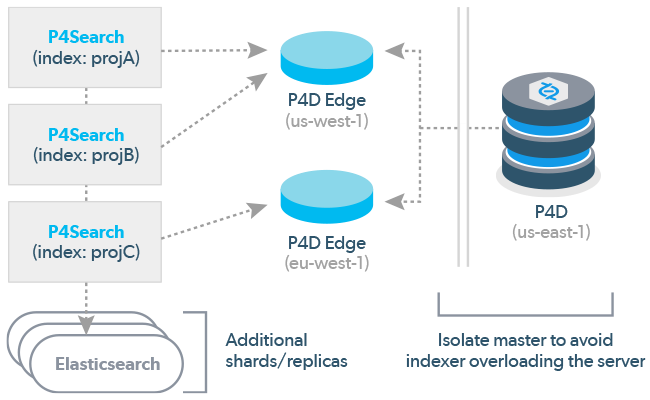Prerequisites
This section describes the prerequisites for the Helix Core Search API, Helix Core Server, and Elasticsearch. The Helix Search service can be deployed in a variety of ways depending on the customers use-case.
The Elasticsearch and Helix Server services can be deployed on the same instance or different instances, but all of the instances must be reachable over the network.
Helix Search service installation requirements
- Windows hosts: Windows 10, Windows 2016 server, Windows 2019 server, or Windows 2022 server
- Linux hosts: Ubuntu 20.04, 22.04 and RHEL 7, 8, 9
- SSL, optional: if you want to use SSL for the Helix Search service, create a Java keystore. For instructions on creating a Java keystore, see Configure SSL security for Helix Search.
Helix Server installation requirements
- Helix Core Server 2021.2 or later
- SSL or non SSL modes supported
- Unicode and non-unicode modes supported
- Connection to a Replica or Edge Helix Server recommended for larger sites
- Connection to a Helix Server Proxy is not supported
Helix Core users
- Perforce Service User: A Standard or Service user with a minimum of admin access. Used to authorize the proxy connection at security level 5 and above. For instructions on creating the Perforce Service User and printing out the ticket, see Create the Perforce Service user .
-
If a Service user is used, the long lived ticket must be a local ticket and not an all hosts ticket.
-
Security level 6 requires the Helix Server to have a valid server spec with the AllowedAddresses field set. For information about Security level 6, see Server security levels in the Helix Core Server Administrator Guide.
- Optional:Perforce Index User: A Standard user with super access. Used to read content from the Helix Server, to set file attributes, and to install extensions. For instructions on creating the Perforce Index User and printing out the ticket, see Create the index user (optional). If the index user is not defined, the Perforce Service user is used.
- Optional:Anonymous Search User: An Anonymous user with read access in the Helix Server for the areas of the depot you want to allow search result access to. The anonymous search user is used for the unsupported search web pages. For instructions on setting the Anonymous User and printing out the ticket, see Create the anonymous search user (optional). If the anonymous user is not defined, anonymous access is disabled.
For Linux installations, after the package install you can run the etc/configure.sh script file to configure users, groups, and the required permissions for Helix Core Server. The etc/configure.sh script file is located in the installation directory. For more details, see Configure using a script.
Elasticsearch installation requirements
-
Elasticsearch 7.15.x to 8.13.x
ImportantHelix DAM may support different versions of Elasticsearch. For the Elasticsearch version that Helix DAM supports, see the Helix DAM Administrator Guide.
Installation scenarios
The following section addresses deployment of the Helix Search service based on the following scenarios:
- Small site deployment of <100 users:Helix Server, Elasticsearch, and Helix Search are all deployed on separate instances and a single Elasticsearch index is used, see Small site deployment
- Large deployment: multiple Elasticsearch indexes are used by Helix Search services from a single Helix Server, see Large site deployment
Helix Search is a self contained Java application designed and tested against AdoptOpenJDK Java 17. The Windows installers and Linux packages deploy their own Java runtime environment (OpenJDK 17) and wrap it as a service.
The Helix Search JAR is available separately from the Perforce website and can be deployed without the need for a service wrapper, see Manually deploy a JAR file.
Small site deployment
A small site deployment typically only requires a single Helix Search service indexing a single Helix Server and a single Elasticsearch index.
Large site deployment
For larger sites the Helix Server data may be too large for a single Elasticsearch index.
The data can be partitioned, with arbitrary depot paths such as by Swarm Project or by Stream, and indexed by different Helix Search instances.

For example:
Two Helix Search deployments using different configured index hosts, for example: projA.perforce.com:1601 and projB.perforce.com:1601
The Elasticsearch index for each Helix Server host MUST be different:
- projA.perforce.com:1601
- projB.perforce.com:1601
com.perforce.p4search.index.name=projA
com.perforce.p4search.index.name=projB
They can point to the same Elasticsearch server because Elasticsearch can scale by adding more Shards/Replicas.
The Helix Server administrator will need to install two Lua Extensions to make sure that the indexing for both instances is kept up-to-date.
Related topics
To deploy and install Helix Search on Windows or Linux use the Helix Search installer (msi installer or deb/rpm package), see Install Helix Search.






